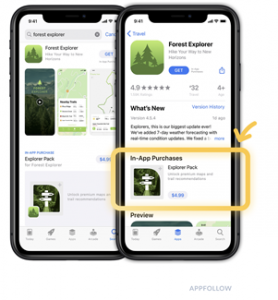It’s not easy for an app to stay competitive considering the number of options in the App Stores. It’s even harder to dominate a category, especially digital health. Knowing the amount of competition that already exists, and that there are a number of apps moments away from launch, brands that have a strong understanding and implementation of App Store Optimization (ASO) are those that land at the top of the search results.
ASO is a key component of obtaining a market reach that acquires enough users to provide sufficient growth. ASO has become a commonplace practice for the large majority of well-performing apps in the ecosystem.
Research has found that 70% of app users use the search function to discover and adopt new apps — proving its effectiveness over word of mouth, which has taken brand marketing by storm. But there is a clear power struggle during the rise of telehealth, wellness brands, and more for their 15 minutes of app store fame; and it’s only getting fiercer and more complex.
One of the most overlooked elements of a brand’s app strategy and store visibility optimization is promoted in-app purchases, specifically the creative logos, design, and text that accompany it. Beauty is in the eye of the beholder, and your consumers are looking to resonate with your health brand and app through its visual – and functional – elements.
Let’s take a look at the 5-step strategy for enhancing your search visibility and in-app experience:
Step 1: Research
First and foremost, you need to research your audiences, competitors, App Store placements, visibility, and more. In this phase, it’s critical to collect as much data and insights as possible on your competitors’ optimization and the state of in-app promotion in the category – both badly executed and extremely successful cases can help sort out your own app strategy.
The components of this research are competitor and success case analysis. Health brands need to know how their competitors are performing in terms of in-apps positioning for keywords and traffic (for both Search and Browse).
What is being done well, what is missing? Looking at the apps in the App Store that have dominated top positions in search results and understanding what they did to achieve this is helpful. Focus on analyzing three elements: promotional images, display names, and descriptions.
Most importantly, do not forget to analyze what your competitors’ users are saying in app reviews, as this can give you valuable insights into what’s working and what to avoid. Understanding this via reviews and ratings can help you position yourself with market context in mind.
Step 2: Design
Using research as a reference, collect a selection of promotional images from your competitors’ in-app purchases. Once you have those, present them to a designer for reference when making your new icons.
What can design do for your brand in this process? It can create a distinct, eye-catching and original design with imagery unlike anything else offered on the App Store. Furthermore, your design is crucial in clearly presenting to current and potential consumers and users the value of what the in-app purchase will provide.
Flo Health, the leading female health & wellbeing app, is a great example of a company who embraced design alongside app store visibility analysis and was rewarded for doing so. After taking a look at competitor’s icons and colors, they were able to alter and customize their in-app purchase designs centered around fresh graphics and people to present more clearly and attractive to the eye.

Step 3: Implement
You’ve done your research and you’ve got a design in mind. Now, it’s time to perform extensive keyword research for in-app metadata. As a brand, you should prioritize long-tail keywords in your search and then add those keywords into the names and descriptions of your in-app purchases.
It’s imperative that these fit the semantic core — the most valuable keywords for the app — and are added into display names and descriptions for in-app purchases without cramming them into a meaningless sequence of keywords (which you can actually be penalized for).
Top tip: It’s more effective to choose keywords with lower or middle popularity for your in-app promotions optimization strategy.
Step 4: Upload
Getting your app updates out the door is very exciting. Once you upload/update your App Store presence, you’ll want to make sure you’re looking at a cause and effect. How do you do this?
Make your changes to the in-app metadata incrementally. For example, upload the new data one week, and the new icons the next. Flo Health uploaded their new in-app data five days before their new icons to give each change its own bucket of time to resonate with consumers.
Here’s a few do’s and don’ts for uploading:
- Never copy the title of your app to in-apps’ names. It will not affect the outcome and can come off as repetitive or boring to users
- Once the changes have been uploaded onto the App Store, you will need to wait between seven to ten days before analyzing the results.
- Once this time is up, see if the changes have had any impact on your traffic or keyword rankings
- If they didn’t, try something new and iterate a recent optimization
- For more clear results, update your in-app texts and icon separately within days of one another
- Well-optimized in-app promotion metadata can have a positive impact on the visibility of your app, as this can help push down competitors in search results
Remember that ASO doesn’t work in a day; it can take time and will forever be a work in progress.
Step 5: Analyze App Store Visibility
The moment of truth. The Flo team waited ten days to let enough data come in and then checked AppFollow’s visibility analysis tool to see the impact of the changes. They clearly saw from the results that these changes had a positive impact on the ranking of their in-app purchases and the app itself.
One crucial area that your App Store strategy should focus on is search visibility scoring, which is done using all the keywords the app ranks for, with the highest popularity and highest positions. For Flo, their in-app search results visibility saw a huge increase of 10% in just a day, which led to an increased number of free organic downloads.
Well optimized in-app promotion metadata can have a positive impact on the visibility of your app as they can help push down competitors in search results. And in the age of telehealth dominating the app scene, it’s imperative that brands are implementing an achievable, and measurable, mobile strategy.
About the author
Ilia Kukharev is the Head of ASO at AppFollow. Since 2012 he is engaged in the localization of websites and mobile applications, as well as ASO-optimization. He is a constant contributor to the ASO community and has been named the ASO marketer of the year by ASO Stack in 2019.





